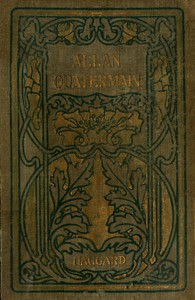Allan Quatermain, H. Rider Haggard [robert munsch read aloud TXT] 📗

- Author: H. Rider Haggard
Book online «Allan Quatermain, H. Rider Haggard [robert munsch read aloud TXT] 📗». Author H. Rider Haggard
This staircase with its supports was, indeed, a work of which any living man might have been proud, both on account of its magnitude and its surpassing beauty. Four times, as we afterwards learnt, did the work, which was commenced in remote antiquity, fail, and was then abandoned for three centuries when half-finished, till at last there rose a youthful engineer named Rademas, who said that he would complete it successfully, and staked his life upon it. If he failed he was to be hurled from the precipice he had undertaken to scale; if he succeeded, he was to be rewarded by the hand of the king’s daughter. Five years was given to him to complete the work, and an unlimited supply of labour and material. Three times did his arch fall, till at last, seeing failure to be inevitable, he determined to commit suicide on the morrow of the third collapse. That night, however, a beautiful woman came to him in a dream and touched his forehead, and of a sudden he saw a vision of the completed work, and saw too through the masonry and how the difficulties connected with the flying arch that had hitherto baffled his genius were to be overcome. Then he awoke and once more commenced the work, but on a different plan, and behold! he achieved it, and on the last day of the five years he led the princess his bride up the stair and into the palace. And in due course he became king by right of his wife, and founded the present Zu-Vendi dynasty, which is to this day called the “House of the Stairway”, thus proving once more how energy and talent are the natural stepping-stones to grandeur. And to commemorate his triumph he fashioned a statue of himself dreaming, and of the fair woman who touched him on the forehead, and placed it in the great hall of the palace, and there it stands to this day.
Such was the great stair of Milosis, and such the city beyond. No wonder they named it the “Frowning City”, for certainly those mighty works in solid granite did seem to frown down upon our littleness in their sombre splendour. This was so even in the sunshine, but when the storm-clouds gathered on her imperial brow Milosis looked more like a supernatural dwelling-place, or some imagining of a poet’s brain, than what she is—a mortal city, carven by the patient genius of generations out of the red silence of the mountain side.
THE SISTER QUEENS
The big rowing-boat glided on up the cutting that ran almost to the foot of the vast stairway, and then halted at a flight of steps leading to the landing-place. Here the old gentleman disembarked, and invited us to do so likewise, which, having no alternative, and being nearly starved, we did without hesitation—taking our rifles with us, however. As each of us landed, our guide again laid his fingers on his lips and bowed deeply, at the same time ordering back the crowds which had assembled to gaze on us. The last to leave the canoe was the girl we had picked out of the water, for whom her companion was waiting. Before she went away she kissed my hand, I suppose as a token of gratitude for having saved her from the fury of the hippopotamus; and it seemed to me that she had by this time quite got over any fear she might have had of us, and was by no means anxious to return in such a hurry to her lawful owners. At any rate, she was going to kiss Good’s hand as well as mine, when the young man interfered and led her off. As soon as we were on shore, a number of the men who had rowed the big boat took possession of our few goods and chattels, and started with them up the splendid staircase, our guide indicating to us by means of motions that the things were perfectly safe. This done, he turned to the right and led the way to a small house, which was, as I afterwards discovered, an inn. Entering into a good-sized room, we saw that a wooden table was already furnished with food, presumably in preparation for us. Here our guide motioned us to be seated on a bench that ran the length of the table. We did not require a second invitation, but at once fell to ravenously on the viands before us, which were served on wooden platters, and consisted of cold goat’s-flesh, wrapped up in some kind of leaf that gave it a delicious flavour, green vegetables resembling lettuces, brown bread, and red wine poured from a skin into horn mugs. This wine was peculiarly soft and good, having something of the flavour of Burgundy. Twenty minutes after we sat down at that hospitable board we rose from it, feeling like new men. After all that we had gone through we needed two things, food and rest, and the food of itself was a great blessing to us. Two girls of the same charming cast of face as the first whom we had seen waited on us while we ate, and very nicely they did it. They were also dressed in the same fashion namely, in a white linen petticoat coming to the knee, and with the toga-like garment of brown cloth, leaving bare the right arm and breast. I afterwards found out that this was the national dress, and regulated by an iron custom, though of course subject to variations. Thus, if the petticoat was pure white, it signified that the wearer was unmarried; if white, with a straight purple stripe round the edge, that she was married and a first or legal wife; if with a black stripe, that she was a widow. In the same way the toga, or “kaf”, as they call it, was of different shades of colour, from pure white to the deepest brown, according to the rank of the wearer, and embroidered at the end in various ways. This also applies to the “shirts” or tunics worn by the men, which varied in material and colour; but the kilts were always the same except as regards quality. One thing, however, every man and woman in the country wore as the national insignia, and that was the thick band of gold round the right arm above the elbow, and the left leg beneath the knee. People of high rank also wore a torque of gold round the neck, and I observed that our guide had one on.
So soon as we had finished our meal our venerable conductor, who had been standing all the while, regarding us with inquiring eyes, and our guns with something as like fear as his pride would allow him to show, bowed towards Good, whom he evidently took for the leader of the party on account of the splendour of his apparel, and once more led the way through the door and to the foot of the great staircase. Here we paused for a moment to admire two colossal lions, each hewn from a single block of pure black marble, and standing rampant on the terminations of the wide balustrades of the staircase. These lions are magnificently executed, and it is said were sculptured by Rademas, the great prince who designed the staircase, and who was without doubt, to judge from the many beautiful examples of his art that we saw afterwards, one of the finest sculptors who ever lived, either in this or any other country. Then we climbed almost with a feeling of awe up that splendid stair, a work executed for all time and that will, I do not doubt, be admired thousands of years hence by generations unborn unless an earthquake should throw it down. Even Umslopogaas, who as a general rule made it a point of honour not to show astonishment, which he considered undignified, was fairly startled out of himself, and asked if the “bridge had been built by men or devils”, which was his vague way of alluding to any supernatural power. But Alphonse did not care about it. Its solid grandeur jarred upon the frivolous little Frenchman, who said that it was all “tres magnifique, mais triste—ah, triste!” and went on to suggest that it would be improved if the balustrades were gilt.
On we went up the first flight of one hundred and twenty steps, across the broad platform joining it to the second flight, where we paused to admire the glorious view of one of the most beautiful stretches of country that the world can show, edged by the blue waters of the lake. Then we passed on up the stair till at last we reached the top, where we found a large standing space to which there were three entrances, all of small size. Two of these opened on to rather narrow galleries or roadways cut in the face of the precipice that ran round the palace walls and led to the principal thoroughfares of the city, and were used by the inhabitants passing up and down from the docks. These were defended by gates of bronze, and also, as we afterwards learnt, it was possible to let down a portion of the roadways themselves by withdrawing certain bolts, and thus render it quite impracticable for an enemy to pass. The third entrance consisted of a flight of ten curved black marble steps leading to a doorway cut in the palace wall. This wall was in itself a work of art, being built of huge blocks of granite to the height of forty feet, and so fashioned that its face was concave, whereby it was rendered practically impossible for it to be scaled. To this doorway our guide led us. The door, which was massive, and made of wood protected by an outer gate of bronze, was closed; but on our approach it was thrown wide, and we were met by the challenge of a sentry, who was armed with a heavy triangular-bladed spear, not unlike a bayonet in shape, and a cutting sword, and protected by breast and back plates of skilfully prepared hippopotamus hide, and a small round shield fashioned of the same tough material. The sword instantly attracted our attention; it was practically identical with the one in the possession of Mr Mackenzie which he had obtained from the ill-starred wanderer. There was no mistaking the gold-lined fretwork cut in the thickness of the blade. So the man had told the truth after all. Our guide instantly gave a password, which the soldier acknowledged by letting the iron shaft of his spear fall with a ringing sound upon the pavement, and we passed on through the massive wall into the courtyard of the palace. This was about forty yards square, and laid out in flower-beds full of lovely shrubs and plants, many of which were quite new to me. Through the centre of this garden ran a broad walk formed of powdered shells brought from the lake in the place of gravel. Following this we came to another doorway with a round heavy arch, which is hung with thick curtains, for there are no doors in the palace itself. Then came another short passage, and we were in the great hall of the palace, and once more stood astonished at the simple and yet overpowering grandeur of the place.
The hall is, as we afterwards learnt, one hundred and fifty feet long by eighty wide, and has a magnificent arched roof of carved wood. Down the entire length of the building there are on either side, and at a distance of twenty feet from the wall, slender shafts of black marble springing sheer to the roof, beautifully fluted, and with carved capitals. At one end of this great place which these pillars support is





Comments (0)